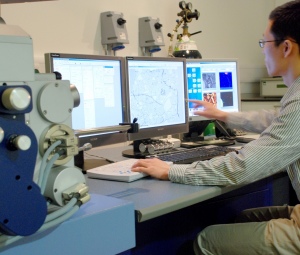

Improving construction materials to make infrastructure more sustainable and durable will be the focus of research at a new £5.4 million lab.
Construction materials underpin our whole society, but we are lagging behind in terms of developing them to meet the complex needs of our modern world.
– Professor Nick Buenfeld
Head, Department of Civil and Environmental Engineering
Bridges, tunnels, and flood defences are some examples of the underpinning infrastructure that keep modern societies functioning. However, one of the major challenges for governments and industry is the drain placed on public and private finances by maintaining such infrastructure over the long-term. Each year, around 50 per cent of the UK’s construction budget is spent solely on upgrading existing infrastructure.
The Advanced Infrastructure Materials Laboratory (AIM) will be the centrepiece of a new Imperial Centre for Infrastructure Materials where researchers will develop a new generation of construction materials that are more durable and robust, able to withstand ever heavier loads, and more cost effective to manufacture and maintain.

AIM researchers will develop a new generation of construction materials
The Centre has been funded by the Engineering and Physical Sciences Research Council. The team will also receive a further £3.6 million to create a network of collaborations with academic institutions across the country – taking the funding total to £9 million for Imperial.
Professor Nick Buenfeld, project lead and head of the Department of Civil and Environmental Engineering, said: “Construction materials underpin our whole society, but we are lagging behind in terms of developing them to meet the complex needs of our modern world. These days materials need to last, be cost effective to make, but also need to be environmentally friendly and enable us to conjure up ever more effective and aesthetically pleasing structures. That is why our new Centre is so important, because it will help to fill the research gap and enable us to develop materials that meet our complex construction needs.”
Making the construction industry more sustainable
At the new Centre, the team will explore ways to make construction materials more sustainable such as through developing new manufacturing methods. Currently, the construction sector uses concrete, steel and asphalt as the main materials in infrastructure. These materials have a huge carbon footprint. For example, the manufacture of concrete accounts for the second largest industrial source of carbon dioxide, contributing to over six per cent of carbon dioxide generated from human sources globally.
Researchers will also explore ways of integrating new types of construction materials with traditional materials. This could enable engineers to develop cheaper and more adaptable ways of maintaining existing infrastructure.
Lab improvements
Imperial’s Centre will be based in the Department of Civil and Environmental Engineering and will consist of a suite of new labs and equipment that will extend the capabilities of the researchers. It will enable them to produce and process a wider range of materials, and image, analyse and test them in more detail. The researchers will also train the next generation of engineers, via an MSc course in Infrastructure Materials, which will start in October 2019.
The Imperial laboratories are funded by the Engineering and Physical Sciences Research Council and sit under the ‘umbrella’ of the UK Collaboratorium for Research in Infrastructure & Cities (UKCRIC). It forms part of a new National Centre for Infrastructure Materials, which includes the Universities of Leeds and Manchester, with overall funding from EPSRC for the combined institutions totalling £16.6M million.
Academic collaboration
As part of the new national centre, the University of Leeds will establish an Infrastructure Materials Exposure Facility, which will be used to analyse how new materials stand-up to long-term weathering conditions associated with ageing infrastructure. The other member of the national centre, the University of Manchester, is establishing a Fire and Impact Laboratory, where new materials will be subjected to extreme conditions to determine their robustness.
Supporters

Article text (excluding photos or graphics) available under an Attribution-NonCommercial-ShareAlike Creative Commons license.
Photos and graphics subject to third party copyright used with permission or © Imperial College London.
Reporter
Colin Smith
Communications and Public Affairs

Contact details
Email: press.office@imperial.ac.uk
Show all stories by this author
Leave a comment
Your comment may be published, displaying your name as you provide it, unless you request otherwise. Your contact details will never be published.




Comments
Comments are loading...